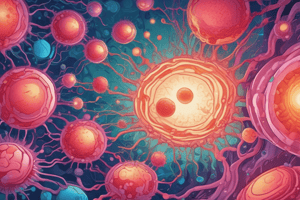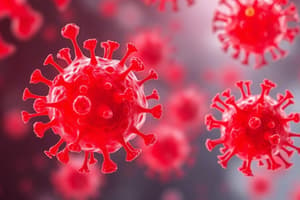Podcast
Questions and Answers
What is the primary function of chemotaxis in leukocytes?
What is the primary function of chemotaxis in leukocytes?
- Release of cytokines into the bloodstream
- Movement toward sites of infection along a chemical gradient (correct)
- Movement away from sites of infection
- Ingestion of foreign particles
Which of the following substances is NOT considered a chemotactic agent for leukocytes?
Which of the following substances is NOT considered a chemotactic agent for leukocytes?
- C5a component of the complement system
- Reactive oxygen species (correct)
- Bacterial products
- Cytokines, especially chemokines
Which type of leukocyte is primarily attracted to viral infections?
Which type of leukocyte is primarily attracted to viral infections?
- Neutrophils
- Eosinophils
- Monocytes
- Lymphocytes (correct)
What is the first step in the process of phagocytosis?
What is the first step in the process of phagocytosis?
Which of the following correctly describes opsonins?
Which of the following correctly describes opsonins?
What role do Neutrophil Extracellular Traps (NETs) play in the immune response?
What role do Neutrophil Extracellular Traps (NETs) play in the immune response?
Which types of reactive substances are involved in the intracellular destruction of microbes?
Which types of reactive substances are involved in the intracellular destruction of microbes?
What occurs to neutrophils during the formation of NETs?
What occurs to neutrophils during the formation of NETs?
Which type of inflammation is characterized by the formation of abundant exudates rich in mucus affecting mucous membranes?
Which type of inflammation is characterized by the formation of abundant exudates rich in mucus affecting mucous membranes?
In which type of inflammation can you find a membrane structure formed by fibrin threads and necrotic cells?
In which type of inflammation can you find a membrane structure formed by fibrin threads and necrotic cells?
What type of inflammation is characterized by a rich fluid exudate and can be observed in conditions like pleural effusion?
What type of inflammation is characterized by a rich fluid exudate and can be observed in conditions like pleural effusion?
What is the first step of leukocyte recruitment from the vascular lumen to the extravascular space?
What is the first step of leukocyte recruitment from the vascular lumen to the extravascular space?
Which type of inflammation involves hyperemia and edema in the submucosa with infiltration of leucocytes?
Which type of inflammation involves hyperemia and edema in the submucosa with infiltration of leucocytes?
Which molecules mediate the rolling of leukocytes along the endothelial surface?
Which molecules mediate the rolling of leukocytes along the endothelial surface?
What characterizes fibrinous inflammation in terms of exudate composition?
What characterizes fibrinous inflammation in terms of exudate composition?
Which of the following statements accurately describes pseudo-membranous inflammation?
Which of the following statements accurately describes pseudo-membranous inflammation?
What triggers the activation of integrins on leukocyte surfaces?
What triggers the activation of integrins on leukocyte surfaces?
Which type of acute inflammation is most commonly associated with localized collections of pus?
Which type of acute inflammation is most commonly associated with localized collections of pus?
What process allows leukocytes to migrate through the vessel wall?
What process allows leukocytes to migrate through the vessel wall?
What are chemokines primarily responsible for during leukocyte recruitment?
What are chemokines primarily responsible for during leukocyte recruitment?
Which condition does not primarily result from type of inflammation involving abundant exudates with high protein content?
Which condition does not primarily result from type of inflammation involving abundant exudates with high protein content?
What role do TNF and IL-1 play in the adhesion of leukocytes?
What role do TNF and IL-1 play in the adhesion of leukocytes?
What is the term used for the migration of leukocytes through the endothelium?
What is the term used for the migration of leukocytes through the endothelium?
Which substance do leukocytes secrete to facilitate passage through the vascular basement membrane?
Which substance do leukocytes secrete to facilitate passage through the vascular basement membrane?
What characterizes hemorrhagic inflammation?
What characterizes hemorrhagic inflammation?
What is the primary causative organism of suppurative inflammation?
What is the primary causative organism of suppurative inflammation?
What happens if an abscess is not evacuated?
What happens if an abscess is not evacuated?
Which of the following correctly describes the composition of pus?
Which of the following correctly describes the composition of pus?
What is the primary function of macrophages in inflammation resolution?
What is the primary function of macrophages in inflammation resolution?
What is a characteristic of allergic inflammation?
What is a characteristic of allergic inflammation?
Which statement about abscess healing is false?
Which statement about abscess healing is false?
Fibrin formation is best described as?
Fibrin formation is best described as?
Flashcards
Leukocyte Recruitment
Leukocyte Recruitment
The process of leukocytes moving from the bloodstream to tissues.
Margination
Margination
Leukocytes accumulating at the edges of blood vessels.
Rolling
Rolling
Leukocytes loosely attaching to the blood vessel lining and then detaching, creating a tumbling motion.
Selectins
Selectins
Signup and view all the flashcards
E-selectin
E-selectin
Signup and view all the flashcards
P-selectin
P-selectin
Signup and view all the flashcards
L-selectin
L-selectin
Signup and view all the flashcards
Firm Adhesion
Firm Adhesion
Signup and view all the flashcards
Integrins
Integrins
Signup and view all the flashcards
Chemokines
Chemokines
Signup and view all the flashcards
Transmigration
Transmigration
Signup and view all the flashcards
Diapedesis
Diapedesis
Signup and view all the flashcards
Chemotaxis
Chemotaxis
Signup and view all the flashcards
Chemotactic agents
Chemotactic agents
Signup and view all the flashcards
Phagocytosis
Phagocytosis
Signup and view all the flashcards
Opsonization
Opsonization
Signup and view all the flashcards
Opsonins
Opsonins
Signup and view all the flashcards
Phagocytes
Phagocytes
Signup and view all the flashcards
Neutrophils
Neutrophils
Signup and view all the flashcards
Macrophages
Macrophages
Signup and view all the flashcards
ROS
ROS
Signup and view all the flashcards
NETs
NETs
Signup and view all the flashcards
Nuclear Chromatin
Nuclear Chromatin
Signup and view all the flashcards
Acute Inflammation (Abscess)
Acute Inflammation (Abscess)
Signup and view all the flashcards
Acute Inflammation (Furuncle)
Acute Inflammation (Furuncle)
Signup and view all the flashcards
Acute Inflammation (Carbuncle)
Acute Inflammation (Carbuncle)
Signup and view all the flashcards
Acute Inflammation (Cellulitis)
Acute Inflammation (Cellulitis)
Signup and view all the flashcards
Non-Suppurative Inflammation
Non-Suppurative Inflammation
Signup and view all the flashcards
Catarrhal Inflammation
Catarrhal Inflammation
Signup and view all the flashcards
Pseudo-membranous Inflammation
Pseudo-membranous Inflammation
Signup and view all the flashcards
Serous Inflammation
Serous Inflammation
Signup and view all the flashcards
Fibrinous Inflammation
Fibrinous Inflammation
Signup and view all the flashcards
Fibrin in Inflammation
Fibrin in Inflammation
Signup and view all the flashcards
Fibrinolysis
Fibrinolysis
Signup and view all the flashcards
Macrophage Clearance
Macrophage Clearance
Signup and view all the flashcards
Inflammation Organization
Inflammation Organization
Signup and view all the flashcards
Hemorrhagic Inflammation
Hemorrhagic Inflammation
Signup and view all the flashcards
Allergic Inflammation
Allergic Inflammation
Signup and view all the flashcards
Suppurative Inflammation
Suppurative Inflammation
Signup and view all the flashcards
Pus Formation Pathogenesis
Pus Formation Pathogenesis
Signup and view all the flashcards
Localized Suppurative Inflammation
Localized Suppurative Inflammation
Signup and view all the flashcards
Abscess
Abscess
Signup and view all the flashcards
Abscess Coagulase
Abscess Coagulase
Signup and view all the flashcards
Abscess Fate
Abscess Fate
Signup and view all the flashcards
Abscess complications
Abscess complications
Signup and view all the flashcards
Study Notes
Inflammation 2
-
Leukocyte Recruitment and Activation
- The series of events for leukocyte recruitment to extravascular space includes margination and rolling along vessel walls, firm adhesion to the endothelium, transmigration between endothelial cells, and migration through interstitial tissues toward a chemotactic stimulus
- Adhesion is mediated by integrins interacting with their ligands on endothelial cells.
- Specific ligands on endothelial cells are activated by TNF and IL-1
- Integrins are low-affinity until activated, then cytoskeleton changes allow firm attachment
-
Margination
- The accumulation of leukocytes at the periphery of blood vessels
- Rolling: Leukocytes weakly bind and detach from the endothelium, tumbling on the endothelial surface
-
Rolling
- Weak and transient interactions mediated by selectins (a family of adhesion molecules)
- Types of selectins: E-selectin (on endothelial cells), P-selectin (on platelets and endothelium), and L-selectin (on leukocytes)
-
Transmigration
- Leukocytes migrate through the vessel wall by squeezing between cells at intercellular junctions (also called diapedesis)
- Leukocyte migration is driven by chemokines, molecules produced in extravascular tissues.
- Leukocytes secrete collagenases to pass through the vascular basement membrane
-
Chemotaxis
- Leukocytes move towards infection or injury sites along a chemical gradient
- Chemotactic agents include bacterial products, pathogenic organisms, cytokines (especially chemokines), and complement system components (e.g., C5a) and leukotrienes from neutrophils
-
Types of Emigrating Leukocytes
- Cocci attract PMNLs
- Bacilli attract monocytes
- Viruses attract lymphocytes
- Parasites and hypersensitivity attract eosinophils
-
Phagocytosis and Clearance
- Ingestion of particulate material by cells
- Three steps: recognition and attachment of the particle, engulfment of the particle to form a phagocytic vacuole, and killing/degradation of the ingested particle
- The most important phagocytes are neutrophils (microphages) and macrophages
- Opsonization enhances phagocytosis
-
Intracellular Destruction
- Reactive oxygen species (ROS), Reactive nitrogen species (derived from nitric oxide), and Lysosomal enzymes (acid hydrolases and elastase)
-
Neutrophil Extracellular Traps (NETs)
- Extracellular fibrillar networks produced by neutrophils in response to infectious pathogens, inflammatory mediators
-
NET Role
- Traps provide high concentrations of antimicrobial substances at infection sites
- Prevents spread of microbes by trapping them in fibrils
- Formation involves nuclear chromatin and granule proteins, such as antimicrobial peptides and enzymes
- Associated with sepsis
-
Types of Acute Inflammation
- Suppurative (Localized/Diffuse)
- Abscess: Localized area of suppurative inflammation
- Furuncle (boil) : Localized suppuration in hair follicle or sebaceous gland
- Carbuncle (localized) : Suppuration in subcutaneous tissue, with multiple loculi and openings
- Cellulitis (diffuse): Diffuse suppurative inflammation of subcutaneous tissue, often caused by strep infection.
- Suppurative (Localized/Diffuse)
-
Types of Acute Inflammation(Continued)
- Non-suppurative
- Catarrhal: Mild inflammation of mucous membranes, characterized by exudate rich in mucus
- Pseudo-membranous: Severe inflammation causing a membrane-like structure on mucous surfaces, often due to bacterial toxins
- Serous: Inflammation characterized by exudation of watery fluid, rich in protein (e.g., pleural effusion, blisters)
- Fibrinous: Inflammation marked by fibrin accumulation, often in body cavities (e.g., pericardium)
- Hemorrhagic: Inflammation featuring blood in the exudate, often due to blood vessel damage
- Allergic: Inflammation triggered by antigen-antibody reactions, characterized by exudate containing eosinophils (e.g., urticaria)
- Non-suppurative
-
Fate of Abscess
- Rupture at point of least mechanical resistance if not drained
- Healing by granulation tissue after evacuation/drainage
-
Complications of Abscess
- Ulcers, fistulas, and sinuses
-
Spread of Infection
- Lymphatic spread (lymphangitis, lymphadenitis)
- Blood spread (toxemia, septicemia, pyaemia)
-
Chronic Abscess
- Failure of complete drainage
Studying That Suits You
Use AI to generate personalized quizzes and flashcards to suit your learning preferences.




